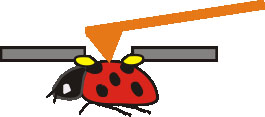Home > Press > Clarkson University Scientists Listen to Faint Sounds Inside Insects
 |
| Rendering of a ladybug being recorded by the atomic force microscope (AFM) probe. |
Abstract:
A team of Clarkson University scientists led by Prof. Igor Sokolov are using atomic force microscopy (AFM) to record sounds emanating from inside living insects like flies, mosquitoes and ladybugs.
Clarkson University Scientists Listen to Faint Sounds Inside Insects
Potsdam, NY | Posted on May 14th, 2010AFM is one of major scientific tools responsible for the emergence of modern nanotechnology.
The unprecedented sensitivity of AFM allowed the Clarkson team to record sub-nano oscillations of very faint amplitude (less than the size of one atom) at high frequencies (up to 1,000 hertz or cycles per second). Previous work in the study of insects was only done at up to 5 hertz. The sounds are recorded by touching the surface of the bugs with an AFM probe.
The study of these sounds may allow researchers to discover unknown features and physiology of insects. Sokolov hopes these discoveries may help in finding solutions to the problems caused by insect pests.
"Insects are of general interest not only as the most numerous and diverse group of animals on the planet, but also as highly efficient bio-machines varying greatly in size," says Sokolov. "Some are major agricultural pests and competitors of humans for crops. Mosquitoes and other insects are important vectors of plant, animal, and human diseases. Also, vast lands of the earth are still underdeveloped because they are occupied by blood-sucking insects."
You can listen to audio files of the internal sounds of mosquitoes, flies, and ladybugs at: ftp.aip.org/epaps/appl_phys_lett/E-APPLAB-96-038950
The Sokolov team's research is published in the top journal of applied physics, Applied Physics Letters, at apl.aip.org/applab/v96/i4/p043701_s1
The team consisted of Sokolov, who has appointments in Physics, and Chemistry and Biomolecular Science; Maxim Dokukin, a physics postdoctoral fellow; and Nataliia Guz, a physics graduate student; and Sergey Vasilyev, instrumental scientist. The other members of Sokolov's group, physics graduate students Dmytro Volkov, Ravi Gaikwad, and Shyuzhene Li, work on biosensors, self-assembly of particles, and the study of skin aging.
Their research was performed within the Nanoengineering and Biotechnology Laboratories Center (NABLAB), a unit established to promote cross-disciplinary collaborations within the University and led by Sokolov. It comprises more than a dozen faculty members to capitalize on the expertise of Clarkson scholars in the areas of cancer cell research, fine particles for bio and medical applications, synthesis of smart materials, advancement biosensors, etc.
####
About Clarkson University
Clarkson University launches leaders into the global economy. One in six alumni already leads as a CEO, VP or equivalent senior executive of a company. Located just outside the Adirondack Park in Potsdam, N.Y., Clarkson is a nationally recognized research university for undergraduates with select graduate programs in signature areas of academic excellence directed toward the world’s pressing issues. Through 50 rigorous programs of study in engineering, business, arts, sciences and health sciences, the entire learning-living community spans boundaries across disciplines, nations and cultures to build powers of observation, challenge the status quo, and connect discovery and engineering innovation with enterprise.
For more information, please click here
Contacts:
Press Contact
Michael P. Griffin
Director of News & Digital Content Services
315-268-6716
Copyright © Clarkson University
If you have a comment, please Contact us.Issuers of news releases, not 7th Wave, Inc. or Nanotechnology Now, are solely responsible for the accuracy of the content.
| Related News Press |
News and information
![]() Researchers develop molecular qubits that communicate at telecom frequencies October 3rd, 2025
Researchers develop molecular qubits that communicate at telecom frequencies October 3rd, 2025
![]() Next-generation quantum communication October 3rd, 2025
Next-generation quantum communication October 3rd, 2025
![]() "Nanoreactor" cage uses visible light for catalytic and ultra-selective cross-cycloadditions October 3rd, 2025
"Nanoreactor" cage uses visible light for catalytic and ultra-selective cross-cycloadditions October 3rd, 2025
Possible Futures
![]() Spinel-type sulfide semiconductors to operate the next-generation LEDs and solar cells For solar-cell absorbers and green-LED source October 3rd, 2025
Spinel-type sulfide semiconductors to operate the next-generation LEDs and solar cells For solar-cell absorbers and green-LED source October 3rd, 2025
Academic/Education
![]() Rice University launches Rice Synthetic Biology Institute to improve lives January 12th, 2024
Rice University launches Rice Synthetic Biology Institute to improve lives January 12th, 2024
![]() Multi-institution, $4.6 million NSF grant to fund nanotechnology training September 9th, 2022
Multi-institution, $4.6 million NSF grant to fund nanotechnology training September 9th, 2022
Announcements
![]() Rice membrane extracts lithium from brines with greater speed, less waste October 3rd, 2025
Rice membrane extracts lithium from brines with greater speed, less waste October 3rd, 2025
![]() Researchers develop molecular qubits that communicate at telecom frequencies October 3rd, 2025
Researchers develop molecular qubits that communicate at telecom frequencies October 3rd, 2025
![]() Next-generation quantum communication October 3rd, 2025
Next-generation quantum communication October 3rd, 2025
![]() "Nanoreactor" cage uses visible light for catalytic and ultra-selective cross-cycloadditions October 3rd, 2025
"Nanoreactor" cage uses visible light for catalytic and ultra-selective cross-cycloadditions October 3rd, 2025
Tools
![]() Japan launches fully domestically produced quantum computer: Expo visitors to experience quantum computing firsthand August 8th, 2025
Japan launches fully domestically produced quantum computer: Expo visitors to experience quantum computing firsthand August 8th, 2025
![]() Rice researchers harness gravity to create low-cost device for rapid cell analysis February 28th, 2025
Rice researchers harness gravity to create low-cost device for rapid cell analysis February 28th, 2025
|
|
||
|
|
||
| The latest news from around the world, FREE | ||
|
|
||
|
|
||
| Premium Products | ||
|
|
||
|
Only the news you want to read!
Learn More |
||
|
|
||
|
Full-service, expert consulting
Learn More |
||
|
|
||








